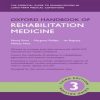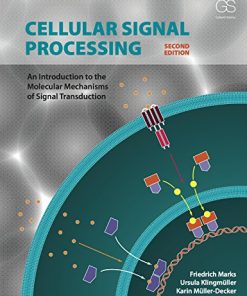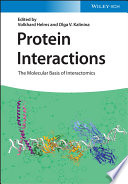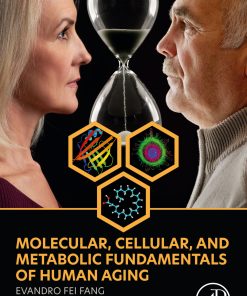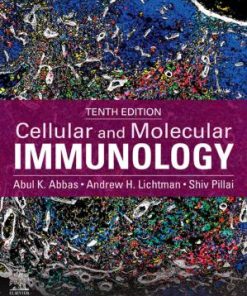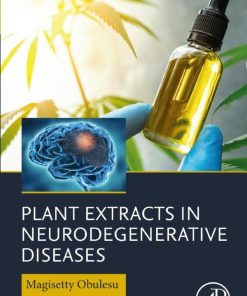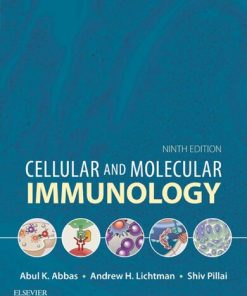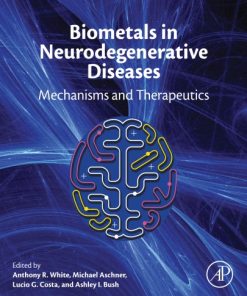The Molecular and Cellular Basis of Neurodegenerative Diseases Underlying Mechanisms 1st Edition by Michael Wolfe 0128113059 9780128113059
$50.00 Original price was: $50.00.$25.00Current price is: $25.00.
The Molecular and Cellular Basis of Neurodegenerative Diseases: Underlying Mechanisms 1st Edition by Michael S. Wolfe – Ebook PDF Instant Download/DeliveryISBN: 0128113059, 9780128113059
Full download The Molecular and Cellular Basis of Neurodegenerative Diseases: Underlying Mechanisms 1st Edition after payment.

Product details:
ISBN-10 : 0128113059
ISBN-13 : 9780128113059
Author: Michael S. Wolfe
The Molecular and Cellular Basis of Neurodegenerative Diseases: Underlying Mechanisms presents the pathology, genetics, biochemistry and cell biology of the major human neurodegenerative diseases, including Alzheimer’s, Parkinson’s, frontotemporal dementia, ALS, Huntington’s, and prion diseases. Edited and authored by internationally recognized leaders in the field, the book’s chapters explore their pathogenic commonalities and differences, also including discussions of animal models and prospects for therapeutics. Diseases are presented first, with common mechanisms later. Individual chapters discuss each major neurodegenerative disease, integrating this information to offer multiple molecular and cellular mechanisms that diseases may have in common.
The Molecular and Cellular Basis of Neurodegenerative Diseases: Underlying Mechanisms 1st Table of contents:
Chapter 1. Solving the Puzzle of Neurodegeneration
Abstract
Introduction: The General Problem of Neurodegeneration
Epidemiology and Clinical Presentation
Molecular Pathology
Genetics
Molecular Clues to Mechanisms of Pathogenesis
Common Themes and Controversies in Neurodegeneration
Animal Models
Prospects for Therapeutics
Conclusions and Perspective
References
Chapter 2. Prion Diseases
Abstract
Introduction and Historical Perspective
Molecular Mechanism of Prion Propagation
The Cellular Prion Protein: Structure and Proteolytic Processing
Physiological Function of PrPC
Mechanisms of PrPSc Toxicity: The N-Terminal Domain of PrPC Possess a Toxic Effector Activity
Human Prion Diseases
Animal Prion Diseases
Prion Strains and Species Barriers
Methods for Propagation and Detection of Prions
Therapeutic Approaches
PrPC and the Alzheimer’s Aβ Peptide
Prion-like Propagation of Misfolded Proteins in Other Neurodegenerative Diseases
Concluding Remarks
References
Chapter 3. Alzheimer’s Disease: Toward a Quantitative Biological Approach in Describing its Natural History and Underlying Mechanisms
Abstract
Quantitative Approach to Basic AD Demographics
Clearance Mechanisms and Impaired Phagocytosis
Calculating Polygenic Risk Scores
Disease-Modifying Strategies: Models of Aβ Accumulation in Alzheimer’s Disease—Implications for Aβ Amyloid-Targeting Therapies
References
Chapter 4. Neurodegeneration and the Ordered Assembly of Tau
Abstract
Acknowledgments
Introduction
Tau Isoforms
Tau Aggregation
Genetics of MAPT
Propagation of Tau Aggregates
Strains of Aggregated Tau
References
Further Reading
Chapter 5. Amyotrophic Lateral Sclerosis and Other TDP-43 Proteinopathies
Abstract
TDP-43 Biology
Amyotrophic Lateral Sclerosis
ALS–TDP-43
ALS–SOD1
ALS-FUS
ALS-C9ORF72
Mechanisms Dysregulated
Other TDP-43 Proteinopathies
Conclusions
References
Chapter 6. Parkinson’s Disease and Other Synucleinopathies
Abstract
Acknowledgment
Introduction: The Pathology of Parkinson’s Disease
Genes Associated with Synucleinopathies
Summary
References
Chapter 7. Huntington’s Disease and Other Polyglutamine Repeat Diseases: Molecular Mechanisms and Pathogenic Pathways
Abstract
Acknowledgments
Polyglutamine Expansion
Posttranslational Modifications
Other Mechanisms
Therapeutic Opportunities for polyQ Diseases
References
Chapter 8. Prion-Like Propagation in Neurodegenerative Diseases
Abstract
Introduction
Prion-Like Proteins in Neurodegenerative Diseases
Mechanistic, Functional, and Pathogenic Properties of Prions
Mechanisms of Transport and Cell-to-Cell Propagation
The Strain Hypothesis
How Prion Strains Might Come to Our Aid
The Issue of Communicability of “Prion-Like” Diseases
Conclusions
References
Chapter 9. Neurodegenerative Diseases as Protein Folding Disorders
Abstract
Introduction
Roles for Protein Folding, Modification, and Degradation
What is Protein Misfolding and Why Does it Occur?
How do Misfolded Proteins and Aggregates Cause Neurodegeneration?
How can Protein Misfolding be Targeted?
Conclusions
Dedication
References
Chapter 10. Heat Shock Proteins and Protein Quality Control in Alzheimer’s Disease
Abstract
Acknowledgments
General Introduction
De Novo Folding, Refolding and Degradation: Triaging
HSP and Proteasomal Degradation
HSP and Autophagosomal Degradation
HSP, UPS, and AD
HSP: Preventing Neurodegenerative Effects of Aβ and Tau
Perspectives
References
Chapter 11. Neurodegenerative Diseases and Autophagy
Abstract
Acknowledgments
Autophagy Cell Biology
Autophagy in Neurodegenerative Diseases
Autophagy Upregulation
References
Further Reading
Chapter 12. Neurodegenerative Diseases and Axonal Transport
Abstract
Introduction to Axonal Transport
Axonal Transport and Neurodegenerative Disease
Alzheimer’s Disease
Huntington’s and Other Polyglutamine Diseases
Spinal and Bulbar Muscular Atrophy
Hereditary Spastic Paraplegia
Amyotrophic Lateral Sclerosis
Charcot–Marie–Tooth Disease
Parkinson’s Disease and Related Synucleinopathies
Frontotemporal Dementia (FTD) and Related Tauopathies
Conclusion
References
Chapter 13. Mitochondrial Function and Neurodegenerative Diseases
Abstract
Acknowledgment
Introduction
Mitochondria and Bioenergetics
Mitochondria in Neurodegenerative Diseases
Therapeutic Targeting of Mitochondria
Conclusions
References
Chapter 14. Non-cell Autonomous Degeneration: Role of Astrocytes in Neurodegenerative Diseases
Abstract
Acknowledgments
Introduction
Astrocytes in Amyotrophic Lateral Sclerosis
Astrocytes in Alzheimer’s Disease
Astrocytes in Parkinson’s Disease
Astrocytes in Huntington’s Disease
Astrocytes in Spinocerebellar Ataxia Type 7
Non-cell Autonomous Roles of Astrocytes in Other Diseases
Perspectives
References
Chapter 15. Neurodegenerative Diseases and RNA-Mediated Toxicity
Abstract
The Identification of RNA-Mediated Toxicity: The Myotonic Dystrophies and CTG Repeats
RNA Foci and the Sequestration Hypothesis in Other Repeat-Associated Diseases
Bidirectional Transcription
Repeat-Associated Non-ATG (RAN) Translation: When RNA Toxicity Results in Proteotoxicity
Conclusions and Therapeutic Directions
References
Chapter 16. Neuroinflammation in Age-Related Neurodegenerative Diseases
Abstract
Peripheral and Brain-Immune Mediators in Brain Health and Disease
The Role of Inflammation in Age-Related Neurodegenerative Disease: A Paradigm Shift
The Role of Peripheral Inflammation in Neurodegenerative Disease
References
Chapter 17. Neurodegenerative Diseases and the Aging Brain
Abstract
Acknowledgment
General Mechanisms Underlying Neuronal Cell Dysfunction and Cognitive Decline
Protein Degradation and Synapse Loss
Unfolded Protein Response
Ubiquitin–Proteasome
Autophagy
Oxidative Damage in the Aging and Neurodegenerating Brain
DNA Break Repair in the Neurodegenerating Brain
DNA Damage Reinforces the Metabolic and Gene Expression Changes in the Aging and Neurodegen
People also search for The Molecular and Cellular Basis of Neurodegenerative Diseases: Underlying Mechanisms 1st
rare neurodegenerative diseases
examples of neurodegenerative diseases
types of neurodegenerative diseases
institute for neurodegenerative diseases of florida
institute for neurodegenerative diseases
Tags: The Molecular, Cellular Basis, Neurodegenerative Diseases, Underlying Mechanisms, Michael Wolfe
You may also like…
Chemistry - Biochemistry
Protein Interactions: The Molecular Basis of Interactomics 1st Edition Volkhard Helms
Medicine - Immunology
Medicine - Pharmacology
Medicine - Immunology
Psychology - Cognitive Psychology
The Sentient Cell: The Cellular Foundations of Consciousness


